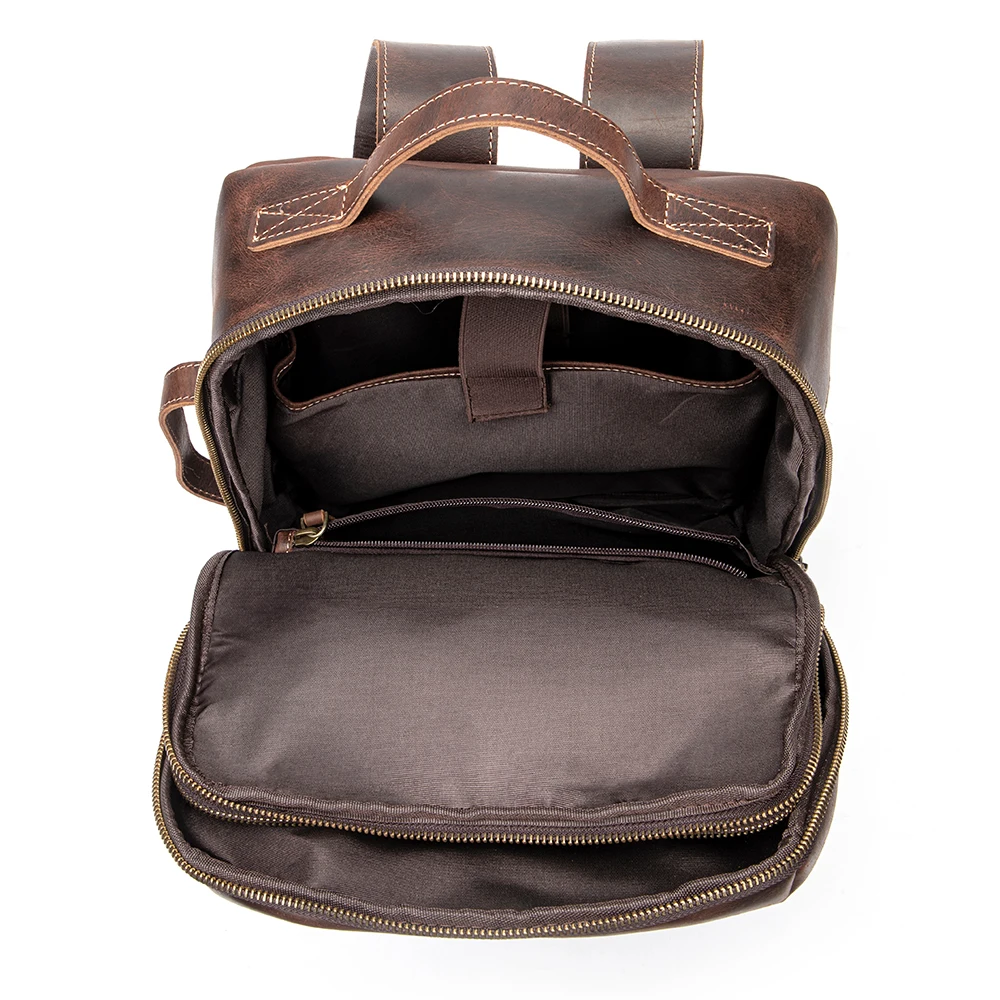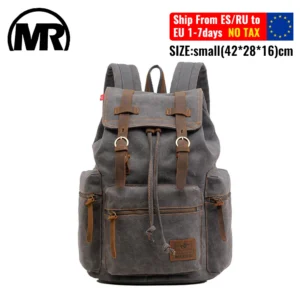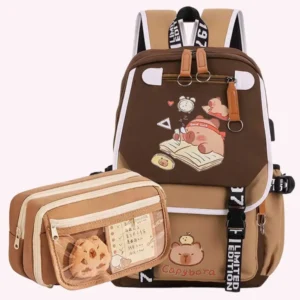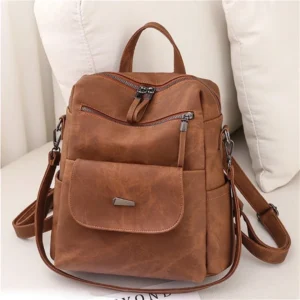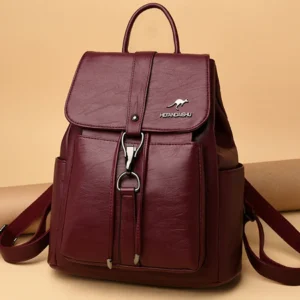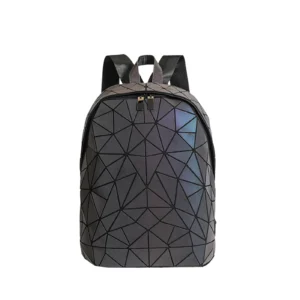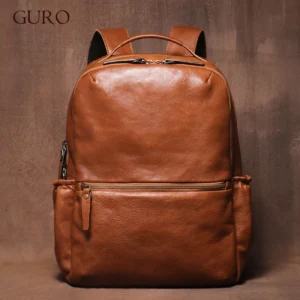Introduction: Why Choose a Leather Rucksack?
A leather rucksack represents the perfect blend of functionality and style—distinct from regular backpacks through its premium materials and typically more sophisticated design. Unlike synthetic alternatives, these bags aren’t just accessories but investments that accompany you through life’s journey.
The appeal of leather rucksacks has remained steadfast throughout changing fashion trends for good reasons:
- Exceptional durability: Quality leather withstands years of daily use while maintaining structural integrity
- Growing aesthetic appeal: Unlike synthetic materials, leather develops a beautiful patina over time, becoming more attractive with age
- Versatility: Seamlessly transitions from professional environments to casual outings
- Value retention: High-quality leather goods often maintain their value and functionality for decades
In this comprehensive guide, we’ll explore everything you need to know before purchasing a leather rucksack—from understanding different leather types to evaluating craftsmanship, design features, and maintenance requirements. Following the Summit Carry philosophy of balancing function, durability, and timeless style, we’ll help you make an informed decision on an accessory that could accompany you for years to come.
Whether you’re new to choosing leather rucksacks or looking to upgrade your current bag, this guide will provide the knowledge you need to select from the many leather rucksack options available today.
Understanding Leather Types: The Foundation of Quality
The quality of a leather rucksack begins with the leather itself. Understanding different leather grades helps you make an informed investment and set appropriate expectations for your purchase.
Leather Grades Explained
Full-Grain Leather: The highest quality option available, this leather includes the entire top layer of the hide with its natural grain intact. It hasn’t been sanded or buffed to remove imperfections, meaning it retains maximum strength and durability. When evaluating leather rucksacks, full-grain leather can be identified by its natural variations, visible pores, and occasional minor imperfections that confirm its authenticity.
Top-Grain Leather: The second-highest quality grade, top-grain has had its uppermost layer sanded and a finish applied. This process removes some natural imperfections and creates a more uniform appearance, though it sacrifices some durability compared to full-grain. It’s still considered excellent quality and is more resistant to staining.
Genuine Leather: Despite its name suggesting authenticity, “genuine leather” typically refers to leather made from lower layers of the hide after the top portions have been split off. It’s often treated with dyes and finishes to mimic higher grades but lacks the same durability and character development.
Bonded Leather: The lowest quality option, bonded leather consists of leather scraps and fibers mixed with adhesives and applied to a backing. While it might look like leather initially, it generally deteriorates quickly and doesn’t develop the patina associated with quality leather.
Tanning Methods and Their Impact
Vegetable Tanning: Uses natural tannins from plant materials, creating leather with rich, warm tones that develops beautiful patina. This traditional method is more environmentally friendly but typically produces slightly stiffer leather initially.
Chrome Tanning: Employs chromium salts for faster production and greater water resistance. Chrome-tanned leather is typically more supple initially and comes in more vibrant colors but may not develop the same depth of character over time.
The optimal leather thickness for backpacks typically ranges between 1.2-2.2mm—thick enough to provide durability but flexible enough for comfortable daily use.
Leather Quality Identification
When examining leather quality, use multiple senses:
- Visual: Look for natural variations in texture and color in higher-grade leathers
- Touch: Quality leather feels supple yet substantial, with a slight give when pressed
- Smell: Real leather has a distinct natural smell, unlike the chemical odor of synthetic materials
- Edges: Examine edge finishing—quality rucksacks feature burnished or painted edges rather than raw cuts
Environmental Considerations
While leather production has environmental impacts, high-quality full-grain leather backpacks can be more sustainable in the long run due to their longevity. A well-made leather rucksack might last decades compared to synthetic bags that need frequent replacement.
| Leather Type | Durability Rating | Maintenance Needs | Price Range |
|---|---|---|---|
| Full-Grain | Excellent (10-20+ years) | Moderate, periodic conditioning | $$$-$$$$ |
| Top-Grain | Very Good (5-15 years) | Moderate, regular cleaning | $$-$$$ |
| Genuine | Fair (2-5 years) | Higher, more frequent treatment | $-$$ |
| Bonded | Poor (1-2 years) | High, deteriorates despite care | $ |
Craftsmanship and Construction: Hallmarks of Excellence
The quality of craftsmanship determines how well a leather rucksack performs over time. Even the finest leather will fail prematurely if poorly constructed. Here’s what distinguishes exceptional craftsmanship:
Stitching Quality
- Evenness and density: Look for tight, uniform stitches with consistent spacing
- Thread material: High-quality waxed thread resists moisture and prevents unraveling
- Reinforcement: Double or triple stitching at stress points (handles, strap attachments)
- Stitch type: Saddle stitching (done by hand) offers superior strength compared to machine lock stitches
Hardware Components
The metal components of your rucksack significantly impact both functionality and longevity:
- Zippers: YKK or RiRi zippers offer smooth operation and long-term reliability
- Buckles and clasps: Solid brass or stainless steel hardware resists corrosion and breakage
- Rivets and studs: Should be firmly secured without damaging the leather
- D-rings and attachments: Look for solid cast pieces rather than hollow or thin-stamped metal
Interior Lining
Quality rucksacks feature thoughtfully selected linings that:
* Protect the interior from wear
* Make contents easier to locate
* Prevent leather oils from transferring to your belongings
* Add additional structure to the bag
Superior vintage leather backpacks often feature cotton canvas or suede linings, while more modern designs might incorporate water-resistant synthetics.
Edge Finishing
The treatment of leather edges reveals much about overall quality:
* Properly burnished edges (heated and polished until smooth)
* Edge paint or coating that prevents fraying
* Folded and stitched edges in high-stress areas
Construction Durability Elements
- Panel attachment methods: How the leather pieces connect affects structural integrity
- Reinforced stress points: Additional leather patches or backing at corners and connection points
- Balance between flexibility and structure: Quality rucksacks maintain their shape while adapting to contents
Proper construction techniques are essential for maintaining leather backpacks over the long term, as no amount of care can compensate for fundamental structural weaknesses.
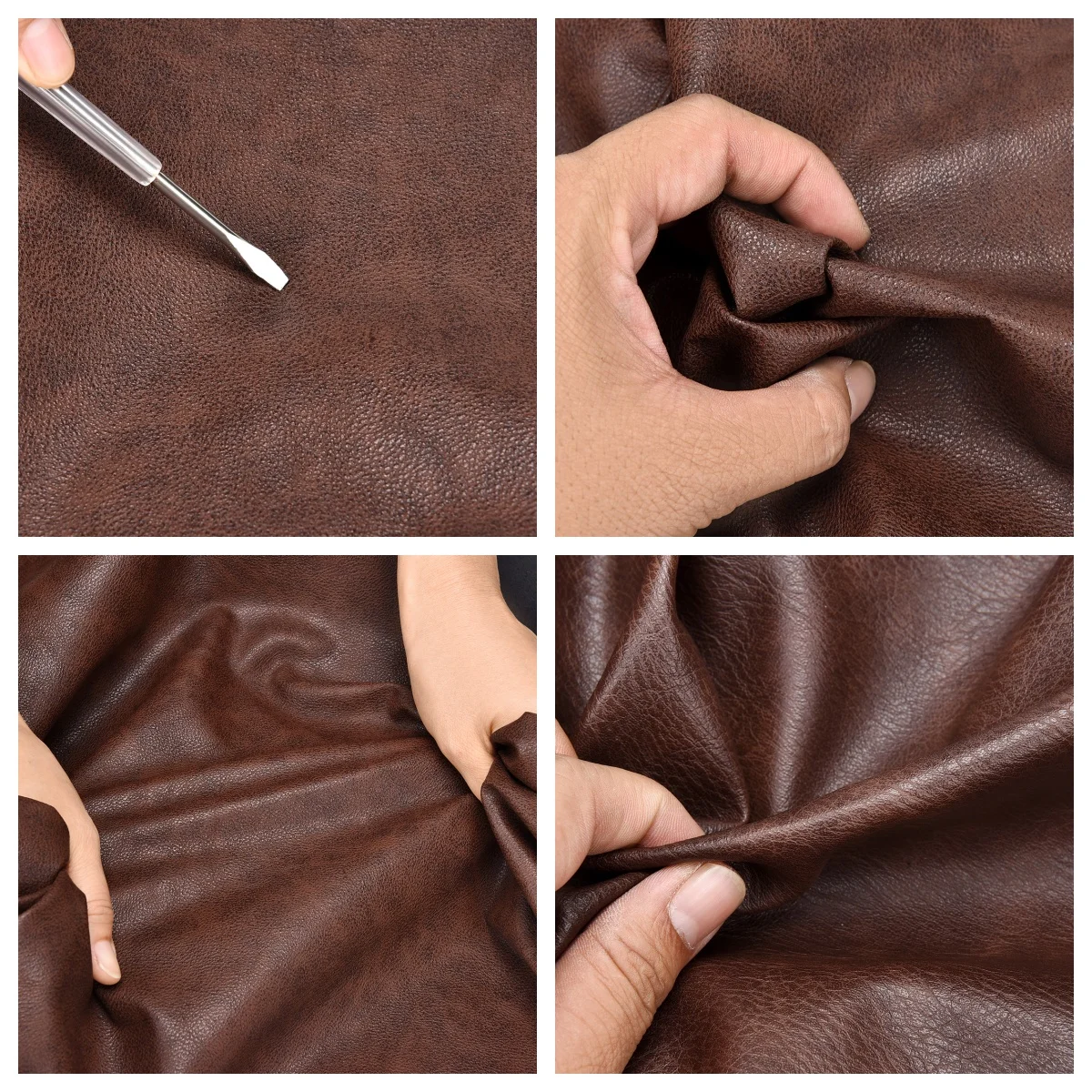
Essential Design Features: Balancing Function and Style
The design of a leather rucksack determines not just its appearance but also how effectively it serves your daily needs. The best designs balance aesthetics with thoughtful functionality.
Compartment Organization
Effective organization transforms a simple bag into an efficient tool:
- Main compartment: Should be spacious with easy access
- Secondary compartments: Separate sections for segregating items by size or importance
- Internal pockets: Specialized storage for smaller items (pens, cards, keys)
- External access pockets: Quick-access storage for frequently needed items
Electronics Protection
Modern rucksacks should accommodate technology:
- Padded laptop sleeves: Preferably suspended slightly from the bottom to absorb impact
- Cord management: Dedicated ports or channels for headphones or charging cables
- Water-resistant compartments: Added protection for valuable electronics
Security Features
- Hidden compartments: Concealed pockets positioned against your back for valuables
- RFID-blocking pockets: Protection for credit cards and passports
- Secure closure systems: Multiple layers of security for main compartments
Closure Mechanisms
Different types of closures for leather backpacks offer varying levels of security, convenience, and aesthetic appeal:
- Buckles: Traditional, secure, and visually appealing, though less convenient for frequent access
- Magnetic snaps: Offer quick access while maintaining a clean appearance
- Zippers: Provide complete closure and easy access but can fail over time
- Drawstrings: Allow flexible capacity but offer less security
Comfort Design Elements
- Padded shoulder straps: Distribute weight effectively across shoulders
- Sternum straps: Optional feature that prevents shoulder straps from slipping
- Back panel design: Ergonomic padding and ventilation channels reduce discomfort
- Handle placement: Multiple carry options for different situations
Different leather rucksack features serve specific use cases—business professionals might prioritize laptop protection and professional appearance, while weekend travelers might value expandable capacity and durability. Classic brown leather backpacks tend to offer the most versatility across different environments and dress codes.
Finding Your Perfect Size: Capacity Guidelines
Selecting the right size leather rucksack ensures it meets your needs without being unnecessarily bulky or restrictively small. Understanding standard sizing and typical use cases helps narrow your options.
Standard Sizing Chart
| Size Category | Capacity (Liters) | Ideal Uses | Typical Contents |
|---|---|---|---|
| Compact | 10-15L | Minimal daily carry, city exploration | Small tablet, wallet, phone, water bottle, light jacket |
| Medium | 16-25L | Standard daily use with laptop | 13-15” laptop, notebook, lunch, water bottle, accessories |
| Large | 26-35L | Overnight trips, gym + work | Clothes, toiletries, laptop, shoes, multiple accessories |
| Travel | 36L+ | Weekend trips, extensive carry needs | Multiple clothing changes, larger electronics, travel essentials |
Matching Size to Purpose
For the most accurate leather rucksack sizing guidance, consider your primary use case:
- Minimalist daily carry: A compact 12-15L rucksack offers sufficient space without unnecessary bulk
- Work commute with laptop: Look for 18-25L capacity with dedicated laptop sleeve
- Versatile work/gym/travel: A 25-30L bag provides flexibility for changing daily needs
- Frequent overnight travel: Large leather backpacks of 30L+ accommodate clothing and essentials
Physical Proportions
Beyond capacity, consider how the bag’s dimensions relate to your body:
- Width: Should not extend much beyond your shoulders for balanced weight distribution
- Height: Typically should not extend higher than 2-3 inches above shoulders or below waistline
- Depth: Deeper bags offer more capacity but can make navigation in crowded spaces difficult
Remember that leather adds weight—even an empty leather rucksack weighs more than synthetic alternatives, making appropriate sizing particularly important.
Comfort and Ergonomics: The Overlooked Priority
While aesthetics often drive leather rucksack purchases, comfort determines whether your bag becomes a daily companion or sits unused. Since leather naturally weighs more than synthetic materials, ergonomic design becomes especially important.
Shoulder Strap Engineering
- Width and padding: Wider straps (at least 2 inches) distribute weight more comfortably
- Contouring: Straps should curve to follow shoulder anatomy
- Attachment points: Reinforced connections prevent failure and improve weight distribution
- Adjustability: Sufficient length adjustment accommodates different body types and wearing styles
Back Panel Design
- Padding placement: Strategic cushioning at shoulder blades and lower back
- Airflow channels: Reduce heat buildup during extended wear
- Spine alignment: Subtle structure that supports natural posture
Weight Distribution Principles
- Center of gravity: Weight should sit close to your back rather than pulling away
- Vertical distribution: Heaviest items should be positioned mid-back rather than at bottom or top
- Compression systems: Straps that tighten the load prevent shifting during movement
Quality men’s leather backpacks incorporate these ergonomic principles while maintaining their sophisticated aesthetic. The best designs make thoughtful compromises that preserve comfort without sacrificing style.
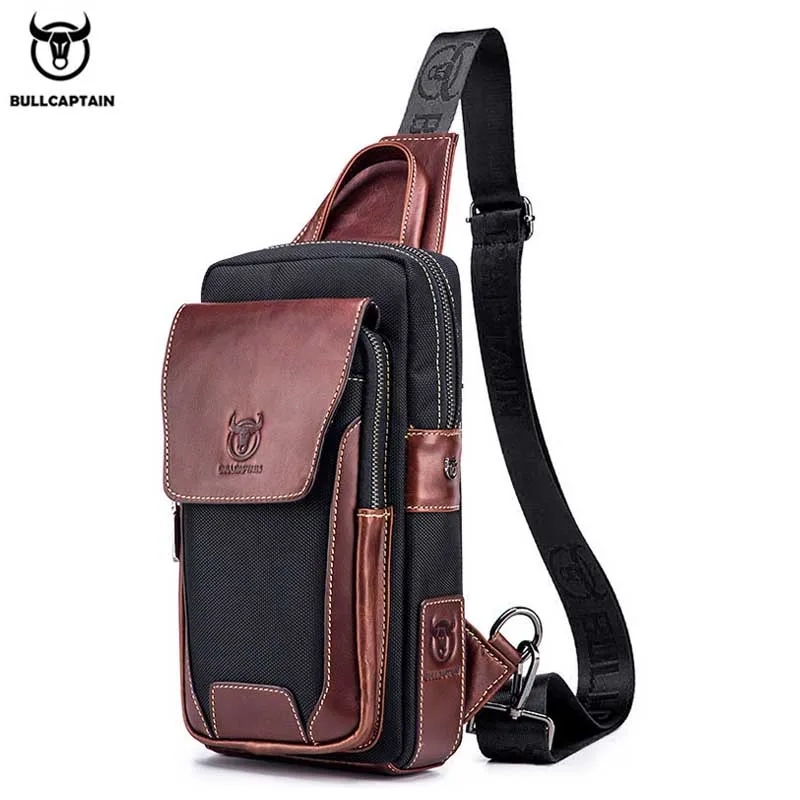
Leather Care: Preserving Your Investment
Proper maintenance dramatically extends the life of your leather rucksack while enhancing its appearance. Unlike synthetic materials that deteriorate regardless of care, quality leather improves with appropriate attention.
Initial Treatment
Before first use:
1. Apply a leather conditioner to hydrate the leather
2. Allow 24 hours for absorption
3. Buff with a soft cloth
4. Consider a water-repellent treatment if you expect weather exposure
Regular Maintenance Schedule
- Weekly: Wipe down with a slightly damp cloth to remove dust and surface dirt
- Monthly: Thorough cleaning with appropriate leather cleaner
- Quarterly: Deep conditioning treatment
- Annually: Comprehensive cleaning, conditioning, and protective treatment
Addressing Common Issues
Water Exposure
* Blot (don’t rub) excess water immediately
* Allow to dry naturally away from direct heat
* Condition once completely dry to restore moisture
Stain Removal
Different stains require specific approaches—oil stains need absorbent powder, while water-based stains often respond to leather-specific cleaning products. Cleaning leather backpacks properly prevents damage during the removal process.
Scratch Prevention and Repair
Minor scratches often respond to gentle rubbing with a fingertip, as natural oils help blend the mark. For deeper scratches, targeted leather conditioner or color-matched polish can minimize appearance. Protecting leather backpacks from scratches extends their aesthetic appeal significantly.
Storage Best Practices
* Store stuffed with acid-free paper to maintain shape
* Use a dust bag or pillowcase for protection
* Place in cool, dry location away from direct sunlight
* Avoid plastic bags which trap moisture
Developing Beautiful Patina
With proper care, leather develops a unique patina—a desirable aging process where the material becomes richer in color and develops character from use. This natural evolution transforms your rucksack into a truly personal item, unlike synthetic materials that simply look worn over time.
Price Considerations: Value Beyond the Price Tag
Leather rucksacks represent a significant investment compared to synthetic alternatives. Understanding what influences pricing helps you allocate your budget effectively and recognize genuine value.
Price Range Expectations
| Quality Tier | Price Range | What to Expect |
|---|---|---|
| Entry-Level | $100-$250 | Genuine or top-grain leather, basic construction, limited features |
| Mid-Range | $250-$500 | Quality top-grain or lower-grade full-grain leather, solid construction, thoughtful features |
| Premium | $500-$800 | High-quality full-grain leather, excellent craftsmanship, distinctive design, premium hardware |
| Luxury | $800+ | Exceptional full-grain leather, artisanal construction, lifetime durability, designer prestige |
Cost Factors Beyond Leather Type
- Construction methods: Hand-stitched bags require significantly more skilled labor
- Hardware quality: Premium metal components substantially increase production costs
- Design complexity: Additional compartments, special features, and intricate details add expense
- Brand reputation: Established luxury brands command higher prices for similar quality
Cost-Per-Wear Value Assessment
While the initial purchase price may seem high, calculating cost-per-use often reveals leather rucksacks as economical choices:
Example: A $600 leather rucksack used daily for 10 years = $0.16 per use
Compared to: A $150 synthetic backpack replaced every 2 years = $0.21 per use
Luxury leather backpacks often represent better long-term value despite higher upfront costs, as they maintain their functionality and appearance far longer than lower-priced alternatives.
14 Inch Leather Laptop Backpack, Brown Leather Backpack, Men's Leather Backpack, Vintage Leather Backpack
Price range: $177.28 through $199.12 Select options This product has multiple variants. The options may be chosen on the product page- Price range: $80.72 through $108.04 Select options This product has multiple variants. The options may be chosen on the product page
Brown Leather Backpack, Women's Leather Backpack
$112.16 Select options This product has multiple variants. The options may be chosen on the product pageLuxury Leather Backpack, Small Leather Backpack, Women's Leather Backpack
Price range: $137.48 through $138.28 Select options This product has multiple variants. The options may be chosen on the product pageDesigner Women's Backpack, Luxury Leather Backpack
Holographic Geometric Laser Diamond PU Leather Women’s Fashion Backpack with Glow-in-the-Dark Design$112.20 Select options This product has multiple variants. The options may be chosen on the product pageFull Grain Leather Backpack, Men's Leather Laptop Backpack, Men's Leather Work Backpack
$353.46 Select options This product has multiple variants. The options may be chosen on the product page
Making an Informed Purchase: Where to Buy Quality Leather Rucksacks
Finding reputable sources for quality leather goods ensures your investment meets expectations for both craftsmanship and authenticity.
Evaluating Brand Credibility
When researching brands, look for:
* Transparent production information: Brands confident in their quality share details about leather sourcing and manufacturing
* Specific leather descriptions: Vague terms like “genuine leather” without further details often indicate lower quality
* Comprehensive warranty terms: Better brands stand behind their products with meaningful guarantees
* Detailed product photography: Close-up images of stitching, hardware, and interior construction suggest confidence in quality
Identifying Quality Independently
Learn to recognize quality regardless of brand name:
* Construction details: Examine stitching consistency, edge finishing, and hardware attachment
* Weight: Quality leather has substantial weight; unexpectedly light bags may use inferior materials
* Smell: Natural leather has a distinctive pleasant scent unlike synthetic alternatives
* Documentation: Better products include care instructions specific to their leather type
Retailer Considerations
Whether shopping online or in person:
* Return policies: Leather goods should have reasonable inspection periods
* Authenticity guarantees: Protection against counterfeit products
* Customer service reputation: Responsiveness to questions indicates general business practices
* Product knowledge: Sales staff should understand leather types and care requirements
Understanding different leather backpack styles and designs helps you communicate your preferences when shopping and ensures you select a rucksack that meets your specific aesthetic preferences.
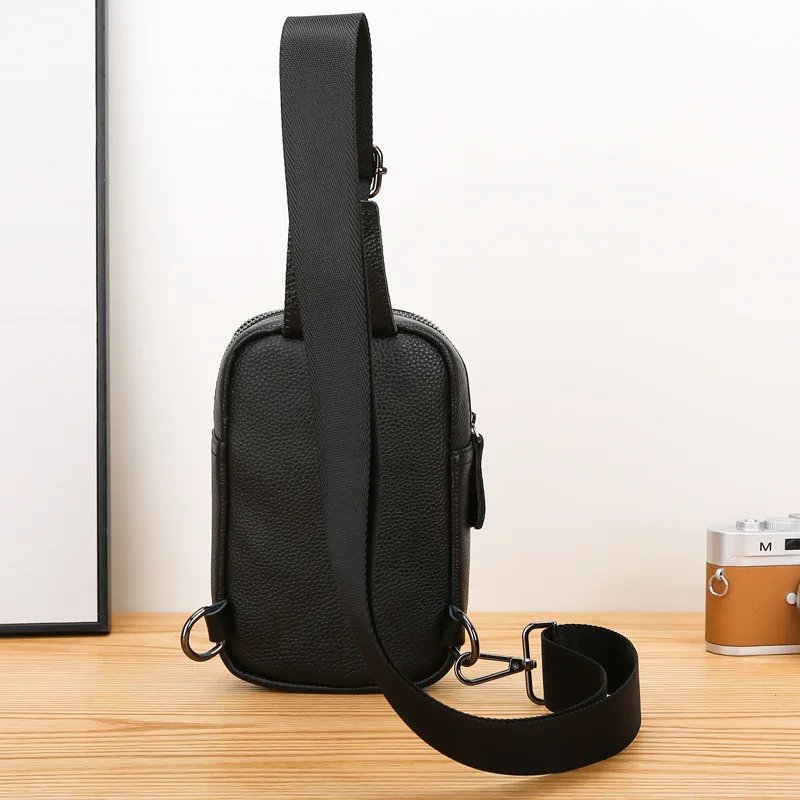
Leather vs Alternative Materials: A Comparative Assessment
While this guide focuses on leather rucksacks, understanding how leather compares to alternatives helps confirm whether it’s the right material for your needs.
Material Comparison
| Material | Durability | Weather Resistance | Maintenance | Aesthetic Aging | Weight |
|---|---|---|---|---|---|
| Full-grain leather | Excellent (10+ years) | Moderate (improves with treatment) | Moderate regular care | Develops rich patina | Heavy |
| Canvas | Good (5-7 years) | Poor to moderate | Machine washable | Fades and frays | Medium |
| Nylon/synthetics | Fair (3-5 years) | Excellent | Minimal | Deteriorates, looks worn | Light |
| Waxed cotton | Good (5+ years) | Very good | Periodic re-waxing | Develops character | Medium |
Environmental Considerations
Leather production has significant environmental impacts, though sustainable practices in leather production are improving industry standards. The environmental equation changes when considering lifecycle—quality leather products can last decades compared to synthetic alternatives that might be replaced multiple times.
Material Selection Scenarios
Leather excels when:
* Long-term durability is essential
* Professional appearance matters
* You appreciate natural materials that age beautifully
* You don’t require frequent washing
Alternatives might be preferable when:
* Minimal weight is critical
* Maximum water resistance is needed without additional treatment
* Regular machine washing is necessary
* You have ethical concerns about animal products
Frequently Asked Questions About Leather Rucksacks
How long does it take to break in a new leather rucksack?
Most leather rucksacks require 2-4 weeks of regular use to begin softening. Full break-in, where the leather fully conforms to your body and usage patterns, typically takes 2-3 months of consistent use.
Can leather rucksacks be used in the rain?
Quality leather can handle light rain exposure, especially when properly treated with protective products. However, prolonged exposure should be avoided. If caught in heavy rain, dry your rucksack naturally (away from heat sources) and condition after it’s completely dry.
How often should I condition my leather rucksack?
Conditioning frequency depends on usage and climate. In general, conditioning every 3-6 months maintains optimal leather health. In very dry climates or with daily use, more frequent conditioning may be beneficial.
What’s the difference between a leather rucksack and a backpack?
While the terms are often used interchangeably, rucksacks traditionally feature a top-loading design with a drawstring or flap closure, while backpacks typically use zippers for the main compartment. Rucksacks often emphasize heritage styling compared to more technical backpack designs.
Is full-grain leather worth the higher price?
For a bag you’ll use regularly for many years, full-grain leather’s superior durability and aging characteristics usually justify the investment. The material improves aesthetically with proper use, unlike lower grades that may deteriorate.
Will leather stretch over time?
Quality leather has some natural give and will slightly conform to contents, but substantial stretching indicates either very thin leather or overloading. A well-made leather rucksack maintains its intended shape while developing character.
Final Considerations: Making Your Decision
Selecting the perfect leather rucksack involves balancing multiple factors according to your unique priorities. This comprehensive guide has covered the essential elements to consider during your search:
- Leather quality: The foundation of your rucksack’s durability and character
- Craftsmanship: Construction techniques that determine longevity
- Design features: Functional elements that enhance daily usability
- Size appropriateness: Matching capacity to your typical carrying needs
- Comfort factors: Ergonomic considerations for regular use
- Maintenance requirements: Care routines that preserve your investment
- Value assessment: Looking beyond initial price to long-term value
- Purchase considerations: Where and how to buy with confidence
Remember that a quality leather rucksack is more than a simple purchase—it’s an investment in an everyday companion that will develop character alongside you. The right choice will serve you well for years or even decades, developing a unique patina that tells the story of your journeys together.
As you make your decision, focus on finding the balance between functionality, durability, and style that aligns with your personal needs rather than following trends. A thoughtfully selected leather rucksack becomes more than an accessory—it becomes part of your personal signature.

